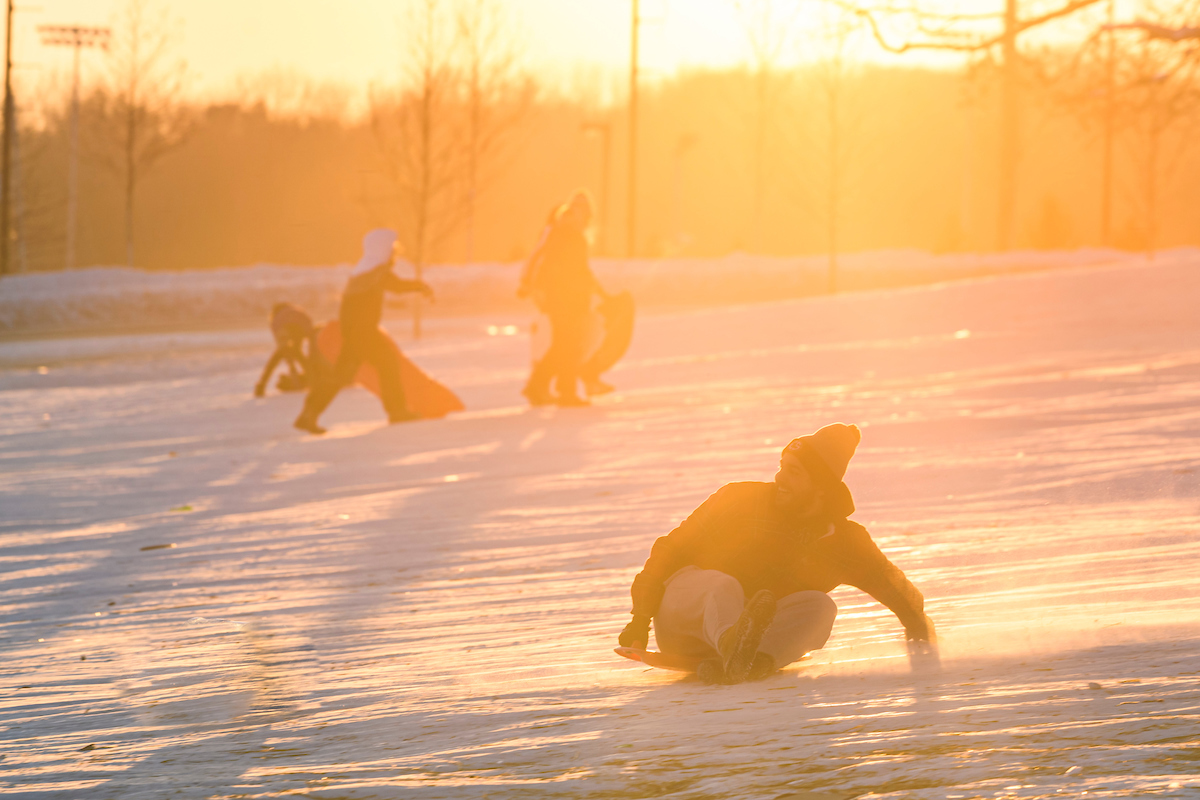From Slayter Hill to the Great Lakes, Midwesterners feel effects of climate extremes
Behind climatologist Melissa Widhalm’s desk is a framed painting of one of Purdue students’ favorite pastimes: sledding down Slayter Hill. Only this painting may look a bit different from what alumni remember from their Slayter experience, and only slightly like what current students experience today. Instead of snow, students are sliding mostly in mud.

“Talk to someone who attended Purdue 20, 30 years ago, and what they remember about Purdue’s sledding tradition is a far cry from what students experience today,” said Widhalm, associate director and regional climatologist at the Midwestern Regional Climate Center. “We haven’t really been able to sled in the last two years because there just isn’t enough snowfall.”
The painting represents what sledding down Slayter Hill might look like in a warmer future climate. Although each snow season is different, when examined over several decades, a noticeable pattern of a decrease in snowfall becomes apparent, and the number of two-inch snowfall events in the future is predicted to follow the trend. In other areas of the state, however, the opposite may occur.
“You may have to travel further north, to northwest Indiana, to find a good sledding spot,” Widhalm said. “This is because of the lake effect.”
The lake effect refers to an area downwind of a lake that gets an enhanced amount of snowfall or precipitation. When an airmass moves over a lake, large temperature differences between the water and the atmosphere can act as an engine to pump a lot of moisture into the air and create massive snow events.
Location in relation to the lake also determines whether lake effects are seen. The wind must pass over a long stretch of a lake to create large amounts of precipitation, and in the winter, winds usually move north to south.
“Take Chicago versus Gary,” Widhalm explained. “Even though Chicago is right next to Lake Michigan, they don’t get nearly as much snow as northwest Indiana because Gary is downwind. Even that 50-mile difference can mean a huge disparity in precipitation.”
Tomas Höök, director of the Illinois-Indiana Sea Grant and professor of forestry and natural resources, said ice coverage issues in the Great Lakes disrupt shipping and fishing, and even pose safety concerns.
“Historically, a lot of people go ice fishing on the Great Lakes, and with less ice coverage they won’t be able to. Those who do face dangerous conditions. Studies have shown that there has been an increase of drownings on the lakes with people falling through ice in the last couple of decades,” Höök said.
Höök also predicts the warming climate to cause highly variable water levels on the Great Lakes, rather than a steady decreasing shoreline like one might expect from oceans.
“Twelve years ago, we had almost record low lake levels with mud flats along the shore of the lake, and four years ago, we had almost record highs. People’s houses fell into the lakes because there was so much erosion,” Höök said. “Shifts in the timing of river runoff, which carry nutrients to the lake in the spring, may also have big effects on the ecology of our lakes due to that reduced ice coverage.”
Another concern for the future is that warming in the Arctic can cause changes in circulation patterns, the culprit behind what many Americans experienced during recent cold temperatures accompanied by heavy lake effect snowfall.
“How will cold air outbreaks interact with ice-free lakes? There are a lot of ingredients that go into that recipe, but what we do know is that a warming atmosphere disrupts many naturally occurring systems, like the polar vortex. It causes cold air from Canada to spill down into the Midwest and mix with warm air, destabilizing weather systems,” Widhalm said, glancing back at the illustration of the muddy hill behind her.
“It’s had a noticeable impact on the community culture. Even if the experience of sledding doesn’t go away, it’s going to be much different for people in the future.”







